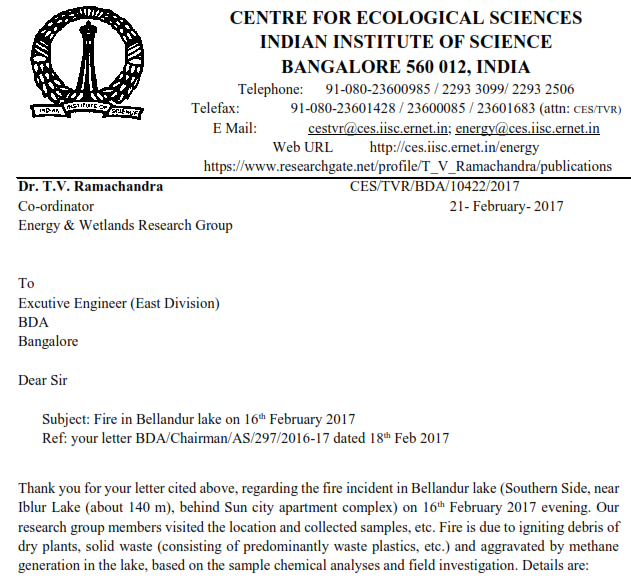|
|
| |
Annexure iv
:

Indicator |
Causal factors |
Fire |
Burning of combustible matter (dry biomass, solid waste, etc.), aggravated by the methane enriched environment.
Igniting dry biomass could be accidental (due to throwing cigarette / beedi) or by desperate residents– to prevent mosquito menace. |
Dry biomass (plant matter) |
The lake has been receiving about 400-450 MLD untreated sewage (rich in N, P, etc.) daily in addition to about 20-30 MLD from the nearby apartments. The availability of nutrients (nitrogen and Phosphorous) in the lake has led to the profuse growth of macrophytes [water hyacinth, (Eichhornia crassipes), Alligator weed (Alternanthera philoxeroides Alternentra), etc.). These weeds by their abundance of leaves, dense vegetation and innumerable rootlets in tertiary manner form a thick mat. These weeds have started drying with increasing temperature and also due to senescence (biological aging) |
Dry biomass (plant matter) |
The lake has been receiving about 400-450 MLD untreated sewage (rich in N, P, etc.) daily in addition to about 20-30 MLD from the nearby apartments. The availability of nutrients (nitrogen and Phosphorous) in the lake has led to the profuse growth of macrophytes [water hyacinth, (Eichhornia crassipes), Alligator weed (Alternanthera philoxeroides Alternentra), etc.). These weeds by their abundance of leaves, dense vegetation and innumerable rootlets in tertiary manner form a thick mat. These weeds have started drying with increasing temperature and also due to senescence (biological aging) |
Dumping of solid waste |
- Solid waste collected in the city are being dumped in the lake since the existence of inefficient regulatory and monitoring mechanism in the city administration.
- Illegal Bangladeshi immigrants (residing in the immediate vicinity of the lake) recover materials, which has economic value and dump the remaining waste materials into the lake. This is happening over five years in the locality, which was brought to the notice of all responsible decision makers, but no action has been taken to either stop these illegal activities or evict illegal immigrants. Continuation of these activities not only hampers lake environment but also threaten the social harmony in the city.
- Throwing household garbage (in the polythene bags) by the residents from the nearby localities. It is observed that many residents while travelling in a vehicle throwing the plythene bags (with solid waste) directly into the lake
|
Methane generation (with anaerobic environment below macrophytes mat) |
Water hyacinth provides suitable breeding places for mosquitoes and other disease-carrying insects, and makes the region (below the mat) anaerobic, leading to the generation of methane. |
Presence of long chain hydrocarbon residues (along with dry biomass) |
In addition to the sewage, untreated industrial effluents from the industries in the catchment has contributed to the favorable environment. Water sample analyses also highlight the contamination due to industrial discharges. |
Implementation of recommendations of the expert committee within reasonable time would bring down such unfortunate instances as well as impending catastrophe due to high level of pollutants in the environment.

|
T.V. Ramachandra
Centre for Sustainable Technologies, Centre for infrastructure, Sustainable Transportation and Urban Planning (CiSTUP), Energy & Wetlands Research Group, Centre for Ecological Sciences, Indian Institute of Science, Bangalore – 560 012, INDIA.
E-mail : cestvr@ces.iisc.ernet.in
Tel: 91-080-22933099/23600985,
Fax: 91-080-23601428/23600085
Web: http://ces.iisc.ernet.in/energy
Durga Madhab Mahapatra
Energy & Wetlands Research Group, Centre for Ecological Sciences, Indian Institute of Science, Bangalore – 560 012, INDIA.
E-mail: durgamadhab@ces.iisc.ernet.in
Vinay S
Energy & Wetlands Research Group, Centre for Ecological Sciences, Indian Institute of Science, Bangalore – 560 012, INDIA.
E-mail: nvjoshi@ces.iisc.ernet.in
Sincy V
Energy & Wetlands Research Group, Centre for Ecological Sciences, Indian Institute of Science, Bangalore – 560 012, INDIA.
E-mail: sincy@ces.iisc.ernet.in
Asulabha K S
Energy & Wetlands Research Group, Centre for Ecological Sciences, Indian Institute of Science, Bangalore – 560 012, INDIA.
E-mail: asulabha@ces.iisc.ernet.in
Sudarshan P. Bhat
Energy & Wetlands Research Group, Centre for Ecological Sciences, Indian Institute of Science, Bangalore – 560 012, INDIA.
E-mail: sudarshan@ces.iisc.ernet.in
Bharath H. Aithal
Energy & Wetlands Research Group, Centre for Ecological Sciences, Indian Institute of Science, Bangalore – 560 012, INDIA.
E-mail: bharath@ces.iisc.ernet.in
Citation: Ramachandra T V, Durga Madhab Mahapatra, Vinay S, Sincy V, Asulabha K S, Sudarshan Bhat, Bharath H. Aithal, 2017. Bellandur and Varthur Lakes Rejuvenation Blueprint, ENVIS Technical Report 116, Environmental Information System, CES, Indian Institute of Science, Bangalore 560012.
|



